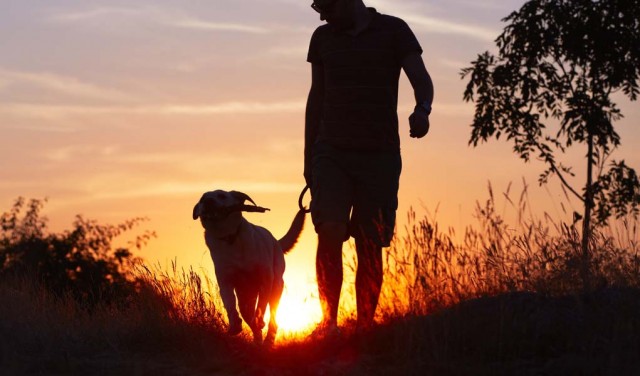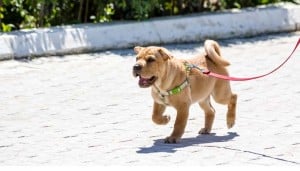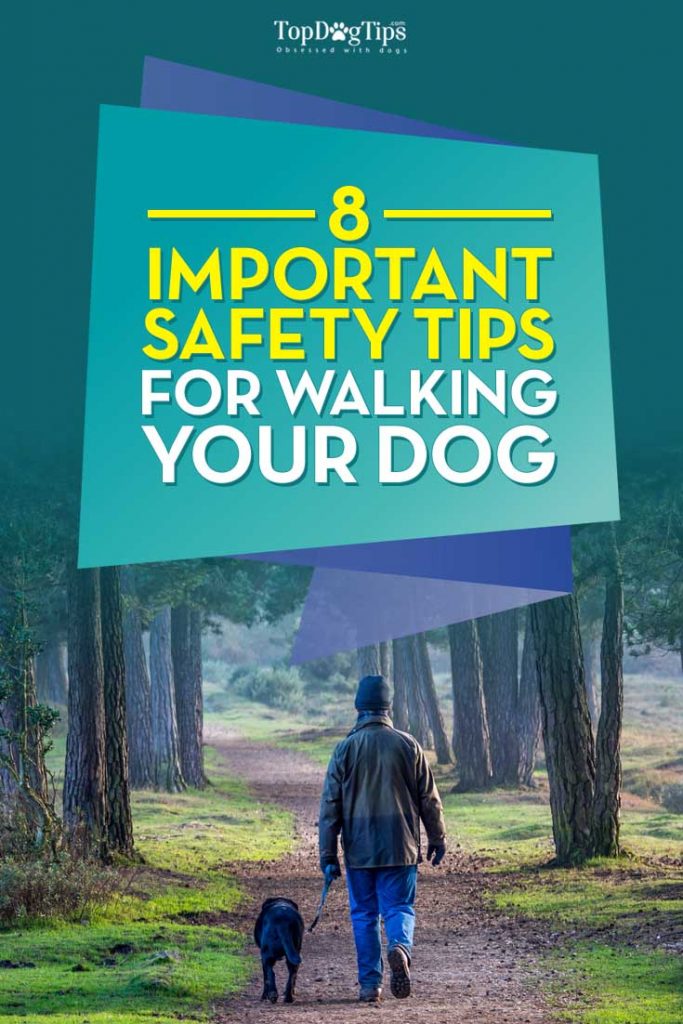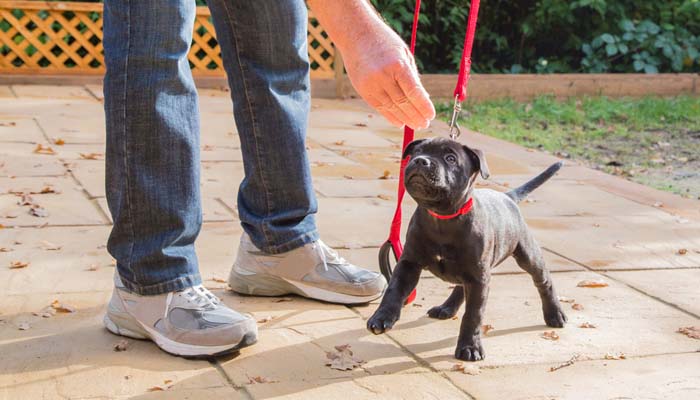
Table of Contents
Our dogs need a lot of exercise – some breeds more than others. Walking your dog on a regular basis is the best way for you both to get the exercise that you deserve. It may sound simple, but there are precautions that you'll need to take to keep you and your Fido safe.
Whether you and your dog are power walkers or prefer to take slow, leisurely strolls, the right apparel and a little extra effort will help you do it safely. Turn each walk into a fun excursion with a side of obedience training. A small amount of effort in the beginning will make walking more enjoyable and safer for you both.
EXPERT's ADVICE: Where and How to Find Good Dog Walking Jobs?
Walking Your Dog: 8 Tips on How To Do It Right
1. Dress for Success
Wear comfortable shoes that will stay on your feet if your dog suddenly changes direction. Tennis shoes or lace-up leather shoes that fit properly are best.
Wear clothing that is a bright color to make yourself more visible. A distracted driver is more likely to notice you crossing the street if you are wearing a bright orange, green, or red top.
If you live where rain showers tend to show up out of nowhere, take along a rain poncho rather than an umbrella. The rain poncho will leave your hands free to control the leash. Keep one on hand for the dog, too. He will be less likely to try to rush back home, and you won’t be walking into your home with a wet, smelly dog.
RELATED: How to Keep Your Dogs Safe on Daily Walks
2. Don’t Be Shy
If walking your dog at night, make yourself and your pet highly visible with reflectors or lights. Even at dusk, there might be enough light for you to see, but you and your dog become much less visible to others. Wear a reflective vest, use a reflective leash, and put a reflective collar on the dog.
If he manages to get away from you, the reflective leash and collar will make it much easier to find him and could save his life if he runs across a street. You can use small, clip-on LED lights for even greater visibility. Wear a cap that lights up, put a couple of clip-on lights on your belt, and put one or two of them on your dog’s collar to make him more visible and increase his safety as well.
Take a flashlight with you to light your way in areas that are especially dark. Use a flashlight that fits in your pocket or can be clipped onto your belt to keep both hands free when you aren’t using it.
RECOMMENDED: 9 Resources on Leash Training Dogs
3. Stay in Your Lane
 Walk your dog on the sidewalk, if possible. When you must walk him in the street, walk against traffic so you are facing on-coming vehicles.
Walk your dog on the sidewalk, if possible. When you must walk him in the street, walk against traffic so you are facing on-coming vehicles.
Put the dog on your left side. You are much more visible to drivers than your dog, no matter how tall he is. He will be much safer walking with you between him and the cars.
The possibility of him darting into the path of a car after a squirrel, cat, or another dog before you realize what he is doing will be greatly reduced if he is on your left. Keep his leash short so he can’t go more than a few inches before reaching the end of it. This will greatly reduce his ability to be hurt by oncoming traffic.
FULL GUIDE: How To Train A Dog To Walk On A Leash
Want more interesting and actionable doggy tips for pet parents? Then remember to subscribe to our YouTube channel for DAILY videos with all things dogs and owners.
4. Get the Right Equipment
 You need to use the right collar for your dog, too. A good doggy harness may be fine for calm, quiet dogs, while stronger dogs may need a head halter to give you enough control to walk them safely.
You need to use the right collar for your dog, too. A good doggy harness may be fine for calm, quiet dogs, while stronger dogs may need a head halter to give you enough control to walk them safely.
Basic obedience training will help, but dogs that tend to pull or try to run after squirrels should wear a head halter.
Use a 3- to 4-foot leather or flat nylon leash when walking your dog. Long, flexible leads that retract into the plastic handle should be reserved for when you have time to take your dog to a park and sit while he explores. The lack of control with long leashes can be hazardous when you are walking your dog on a sidewalk around other people and dogs.
For owners wanting to equip themselves with the right dog-walking equipment, we have several well-researched lists to peruse:
- The Best Dog Leash
- The Best Dog Harness
- The Best Dog Collar
- The Best Hands-Free Dog Leash
- The Best Dog Booties
- The Best Dog Backpack
Some equipment breaks, dogs occasionally escape and get lost, and other things may go wrong, especially when you go for longer walks with your dog. Ensuring that you have everything you need when you embark on longer walks with your pet is important.
FULL GUIDE: How To Stop A Dog From Pulling – Step-By-Step Instructions
5. Focus on What’s Important
Take your phone with you for safety, but leave the earbuds at home. Walking your dog safely requires your undivided attention. The phone should be used only if you need to call for help. Chats with friends can wait until you get home.
Walks should be “us time” for you and your dog only – no earbuds or headphones. You need to stay alert and be aware of what’s going on around you.
If you are listening to music, you will not hear another walker, jogger, or biker coming up behind you. You or your dog could easily swerve into their path, causing an accident and possible injuries.
RELATED: Types of Dog Leashes and How to Choose the Right One
6. Keep Cool and Stay Hydrated
Walking your dog safely in hot weather takes a little more preparation and maybe even a change of venue. Have a bottle of water with you at all times when walking your dog, especially in warm weather.
The risk of heat sickness or heat stroke for you and your dog rises with the temperature.
Dogs can quickly become dehydrated and overheated before you realize what’s happening. This is especially true of brachycephalic dogs (dogs with “pushed-in” muzzles) like pugs and French or English bulldogs. Their short muzzles make it more difficult to cool themselves.
If you need water, your dog probably does too. When you get thirsty, take a drink of water and pour some water into your cupped hand for the dog. Do not walk your dog if the sidewalk is too hot for you to stand on comfortably in bare feet. If it is too hot for you, it is too hot for his bare paws.
Walking your dog early in the morning before the pavement heats up on hot days is safer and much more comfortable for you both. Take him to a park with walking trails that are cool and shady if you can. The new surroundings will be an added benefit, giving you a change of scenery and the dog some exciting new sights, sounds, and smells to explore.
RELATED: Does Your Puppy Need Dog Boots?
7. Leave Room for Training
Incorporate some basic obedience training into your walking routine. It will pay off in the long run, making walking your dog safer and more enjoyable for you both. Put some bite-sized treats in a baggie and put it in your pocket before walking out the door. Make sure they are small enough for the dog to gobble down quickly in one bite.
Use the best dog treats to reward your pooch each time he does something right. Dogs learn much better when rewarded with tasty treats and praise. Teach him to walk safely at your health until you tell him it is okay to take a few minutes to explore and relieve himself.
Help him understand the difference between the sidewalk and the street. Take the time to stop before crossing the street, even when there is no traffic, and make him sit. Wait a few seconds, double-check for traffic, tell the dog “okay,” then proceed across the street. This practice will add only a few minutes to the walk, and it could save his life.
RELATED: How to Start a Dog Walking Business
8. Keep Off the Grass
Do not allow your dog to wander on other people’s lawns. Chemical fertilizers and pesticides that many people put on their grass can burn a dog’s paws and nose. They can also cause damage to a dog that may not become evident for many years.
Walk your dog safely on the sidewalk. When you can see granular chemicals on the sidewalk in front of you, try to avoid them. Cross the street or walk the dog in the street until you get beyond the chemicals.
For more tips on dog walking or how to train your dog's essential commands, take a look at our in-depth guide and video below. Want more? Subscribe on YouTube!
FULL GUIDE: How To Train A Dog Basic Commands – Step-By-Step Instructions


















